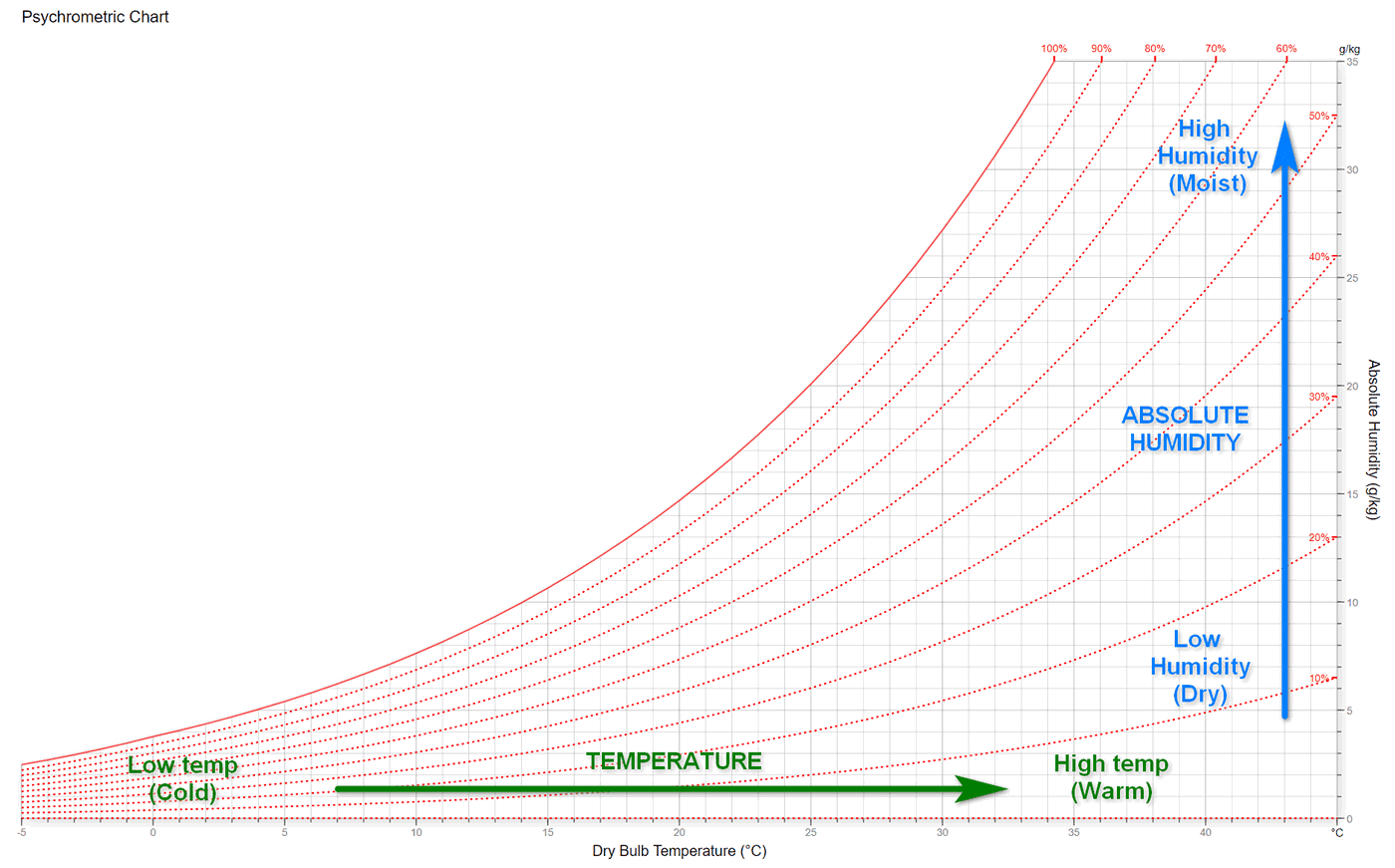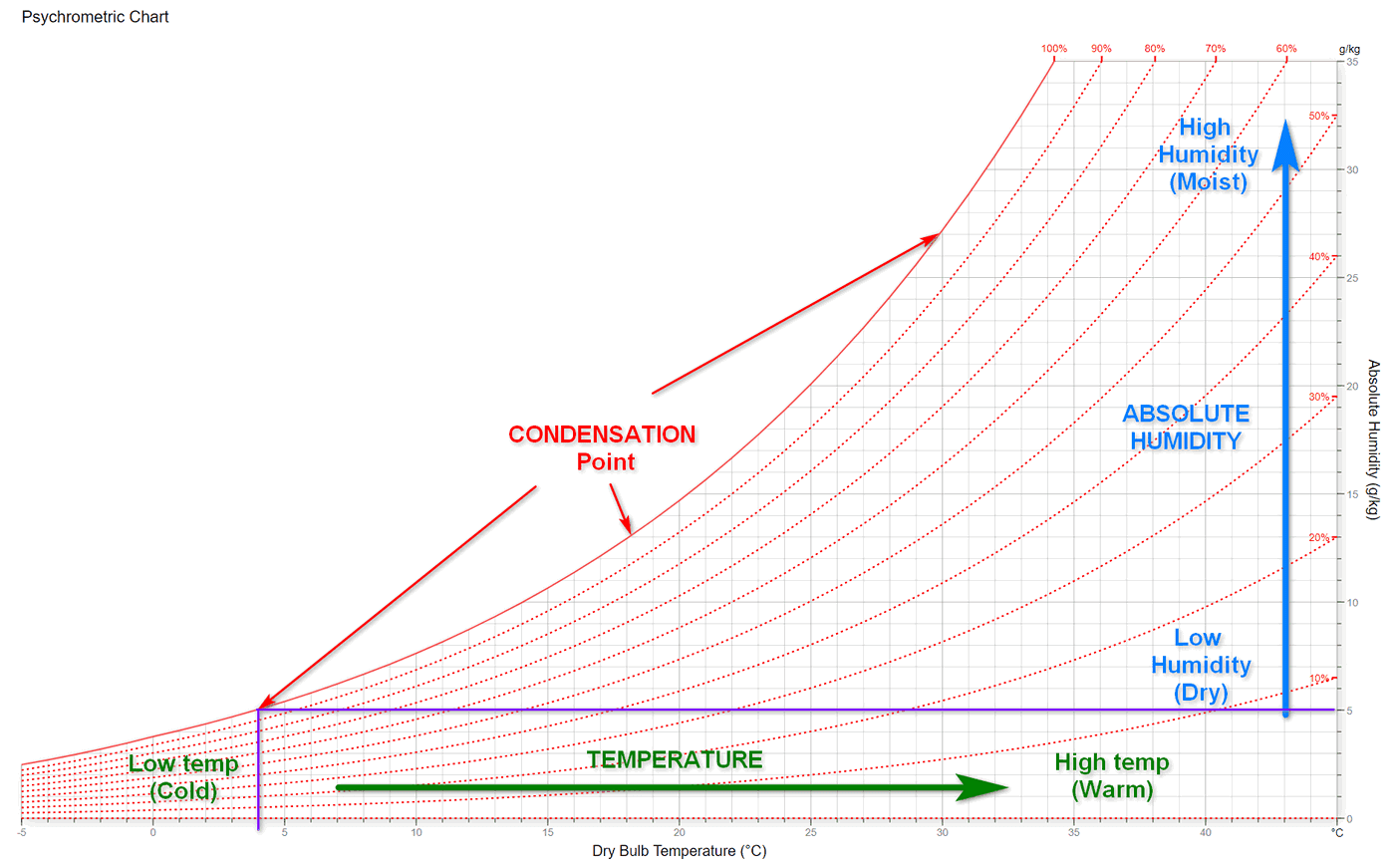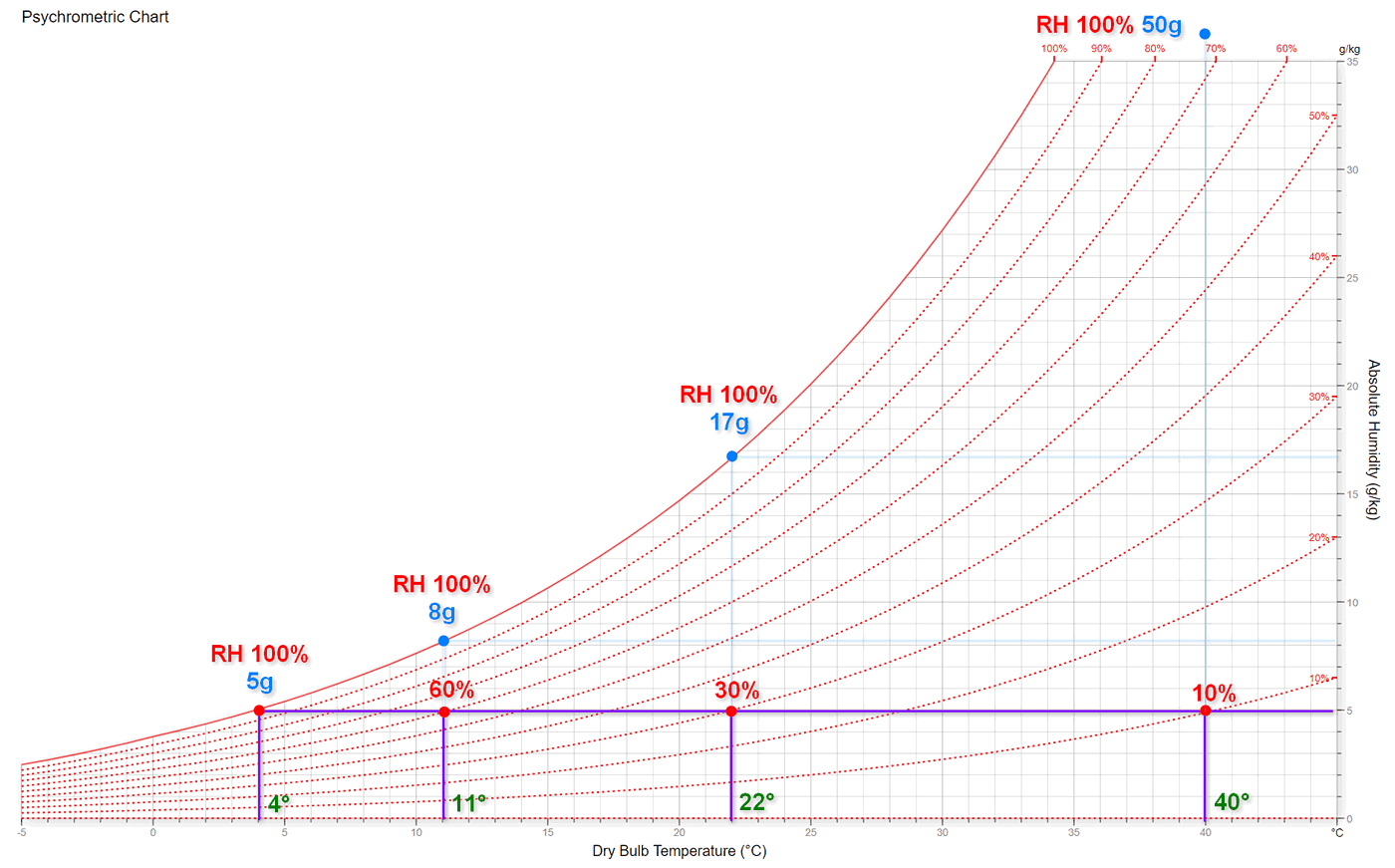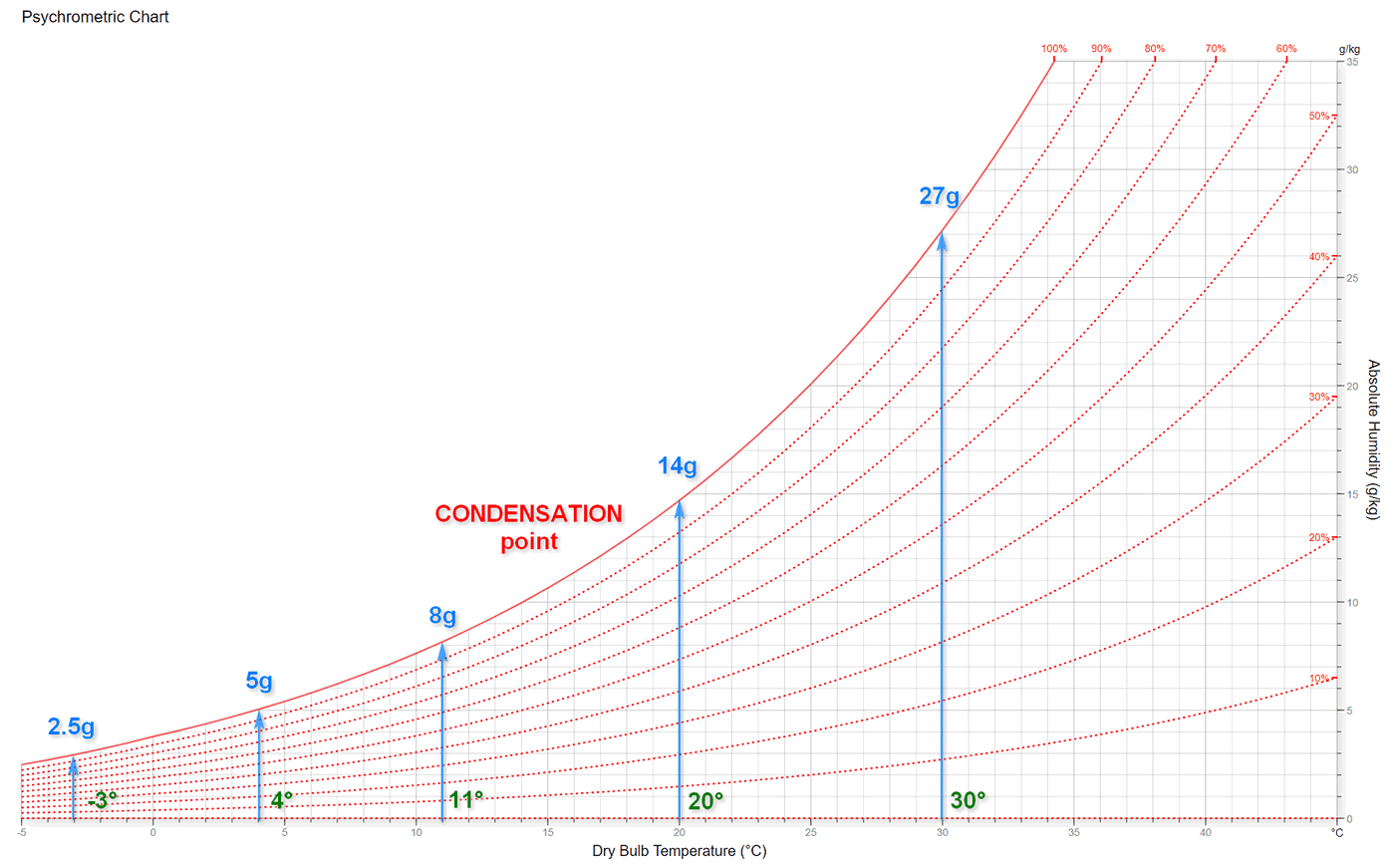What is Condensation?
Condensation occurs when moist air (usually warm moist air found indoors) comes in direct contact with colder surfaces (e.g. walls, window panes). It is more prevalent at the bottom of external walls and cold corners or in places where moisture stagnates - in areas with little or no ventilation (e.g. behind furniture).
During condensation, water changes its state from vapour to liquid.
A common sign of condensation is the appearance of black mould. Mould needs water to survive and condensation moisture supplies this vital ingredient.
Understanding Condensation - The Basics
Condensation involves the phase transformation of water between vapour and liquid as a result of temperature changes. To understand why and how this occurs, as well as how to best solve if it becomes a problem, let's look at a condensation chart - the whole concept is much simpler than it looks.
The chart has 2 axis:
- The horizontal axis: shows the temperature, from cold to warm.
- The vertical axis: shows the humidity, from dry to moist.

Condensation chart
Now, a few words about humidity. Humidity in the air is present in form of (invisible) water vapors. But that's still "real" water often referred to as absolute humidity. It is expressed in grams/m³, telling us how many grams of water exists in each m³ of airspace. Up to about 5 g/m³ moisture the content is considered normal. For e.g. in case of a smaller room of 4.0 x 3.0 x 2.5 meters having a 30 m³ volume, this adds up to 30 m³ x 5 g = 150 grams of total water - about a cupful. This is how much water is "floating around" invisibly in that room. In cellars you can easily have double of this (8-10 g/m³) or more, totaling about 300 grams of water in the airspace; which in our example amounts to as much liquid as a bottle of beer.
What is interesting: how much of this water stays "afloat" in the air and how much of this condenses on window panes or walls, it greatly depends on the surrounding temperatures. Here is why.
Cooling
One of the differences between cold and warm air is the volume it occupies. Warm air expands, taking up more volume than cold air; as a result warm air can "hold" more water vapors than cold air.

Cold temperatures favor condensation
If we continue with our example: we have a room with 5 g/m³ absolute humidity - shown by the horizontal purple line on the chart. As temperatures drop, at some point we reach a critical temperature (in our case around 4°C, shown by the small vertical purple line) - at this temperature the air volume just "barely" can hold the 5 gram humidity. If the temperature keeps dropping even a bit, the shrinking volume of air won't be able to hold all that vapour, releasing some of it in form of condensation. This "critical" temperature at which condensation starts occurring is called the dew point or condensation temperature. This is expressed by the solid red line (corresponding to 100%) on the chart above.
Although the concept of absolute humidity (real water content) is very simple and straightforward, most humidity meters in use measure a different humidity value: relative humidity (RH), which expresses the amount of humidity (%) against saturation (100%) at that given temperature. The reason behind this is the complexity of technology (and cost) of measuring absolute humidity, hence only high-end humidity meters measure absolute humidity.
And with two ways of measuring and expressing humidity - as absolute humidity (the real water content) and relative humidity (water percentage to saturation at a given temperature) - things become a bit confusing. But let's carry on with our example to make this concept clear.
So, we have 5 g/m³ absolute humidity (water vapors) in the room. Let's say our room is well heated at 22°C. At this temperature the water vapors only take up 30% of the air's maximum holding capacity (known as 30% relative humidity), being far away from the 100% condensation point. However, if temperatures start dropping, things change: at 11°C our 5 g of vapor takes up 60% of the air's total holding capacity, then at 4°C all 100%, reaching the condensation threshold (100% RH) under which condensation starts occurring.

Relative humidity is temperature dependent
The lower the temperature, the more abundant the condensation becomes. As you can notice, at very low temperatures the red RH curves converge to zero, which indicates that very cold air can't hold almost any humidity, and at lower temperatures virtually everything condenses (and freezes).
Heating
When heating kicks in, things happen in reverse. The higher the temperature (or warmer a room becomes), the more water the air can hold and further away we get from the condensation threshold or dew point, where water starts liquefying. We haven't done anything with the humidity in the room, we are just "managing it" with the help of some warm air.
So by turning on heating, we increase the the air's moisture holding capacity, which takes us away from the "critical" condensation temperature. That's why heating generally works with condensation problems. Will it solve all condensation problems? No, it won't, as there is one more important aspect we need to be aware of - the problem of excess humidity.
The Problem of Excess Humidity
Looking at the condensation chart again. we can notice, that for any temperature value there is a corresponding absolute humidity (amount of water vapor in the air) that results in condensation.

Condensation can occur even at high temperatures if high humidity levels are present
In other words, condensation can occur regardless of temperature, even at high temperatures, if humidity levels are high enough.
Just think of a bathroom after a long shower, Everything is misty, the mirror and walls are dripping from condensation even warm, internal walls. As per the chart above, at 20°C we get condensation on warm surfaces at 14 g/m³ absolute humidity. What we have here is a humidity saturated environment. The solution in this case is airing (or ventilation) to flush out all the excess vapor e.g. by opening a window.
Similarly, we can have condensation at even higher temperatures, at 30°C or 40°C, if humidity is high enough - just think of a tropical rain forest, where it rains abundantly every day and despite of the tropical heat everything is just musty, moldy and wet. This is a persistent larger scale condition - a global humidity saturated environment.
Similar humidity saturated conditions also exist in old buildings and one should be aware of this phenomenon. This is a special case of condensation, which can persist long-term despite of adequate heating.
We are going to discuss the various condensation types in more details in the next section.
Summary
- Condensation involves the phase transformation of water between vapour and liquid as a result of temperature changes.
- The temperature of the air determines how much water the air can hold. Warm air can hold more water vapors as it expands in volume. Cold air can hold a lot less water (vapors) than warm air.
- Absolute humidity (AH) expresses the "real" amount of water in the air. It is a temperature independent metric.
- Relative humidity (RH) expresses how saturated with humidity the air is at a certain temperature. It is a temperature dependent metric. For e.g. 40% RH means that we are at 40% at the air's total moisture holding capacity, where 100% would be the air's moisture saturation point.
- At 100% RH condensation occurs - some of the water vapors will be discharged from the air in form of condensation or liquid water.
- Heating can solve many (but not all) condensation problems, and does it by increasing the air's moisture holding capacity. It does not make the moisture go away.





